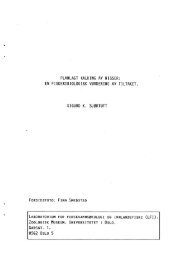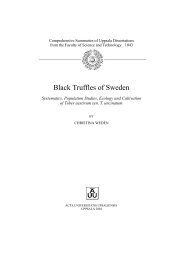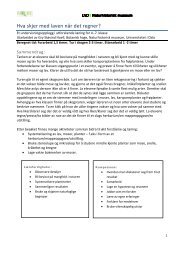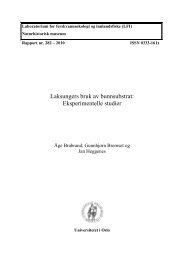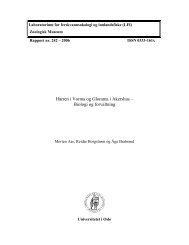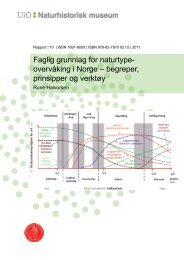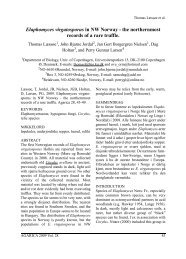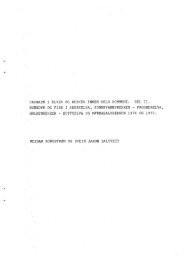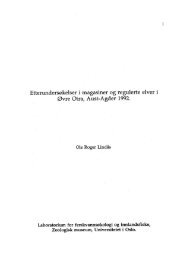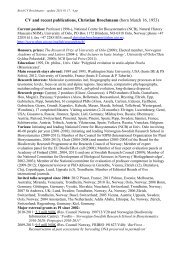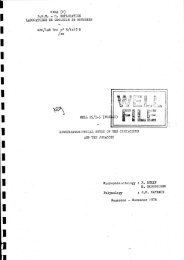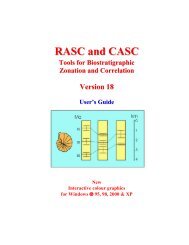Truffle trouble: what happened to the Tuberales?
Truffle trouble: what happened to the Tuberales?
Truffle trouble: what happened to the Tuberales?
- TAGS
- truffle
- www.nhm.uio.no
You also want an ePaper? Increase the reach of your titles
YUMPU automatically turns print PDFs into web optimized ePapers that Google loves.
1082 T. Læssøe, K. Hansen<br />
Table 1 – Evaluation of different constrained tree <strong>to</strong>pologies in MP and ML analyses, compared with <strong>the</strong> MPTs and <strong>the</strong><br />
optimal MLT, respectively, using <strong>the</strong> Kishino–Hasegawa test for MP and <strong>the</strong> Shimodiara–Hasegawa test for ML ( p < 0.05)<br />
Tree MP ML<br />
Tree lenght a<br />
consensus tree of <strong>the</strong> three MPTs is nearly completely resolved,<br />
but as for <strong>the</strong> lineages A and B <strong>the</strong> deep level relationships<br />
are poorly supported. Pyronemataceae are suggested <strong>to</strong> be<br />
paraphyletic, because Ascodesmidaceae are nested within it.<br />
Ascodesmidaceae are highly supported as monophyletic<br />
(Fig 4). Twelve clades of pyronemataceous taxa are recovered<br />
by all analyses, which correspond <strong>to</strong> those identified by Perry<br />
et al. (2007) who used a much larger taxon sampling. The nine<br />
truffle species included are nested within three, moderate <strong>to</strong><br />
highly supported clades with apo<strong>the</strong>cial pyronemataceous<br />
taxa (Fig 4). The five species of <strong>the</strong> hypogeous genus Genea<br />
form a monophyletic group (PB 86 %, PP 99 %), as a sister group<br />
<strong>to</strong> <strong>the</strong> epigeous Humaria hemisphaerica (PB/PP 100 %). The truffle<br />
Geopora cooperi, forms a highly supported monophyletic<br />
group with five epigeous species of Geopora (PB/PP 100 %).<br />
Geopora is suggested <strong>to</strong> be a sister group <strong>to</strong> a clade of <strong>the</strong><br />
apo<strong>the</strong>cial Ramsbot<strong>to</strong>mia, Scutellinia, and Miladina (PP 100 %).<br />
The truffles Stephensia and Paurocotylis pila form a highly supported<br />
group with apo<strong>the</strong>cial Tarzetta and Geopyxis (PB 99 %, PP<br />
100 %). Stephensia is suggested <strong>to</strong> be non-monophyletic;<br />
Stephensia bombycina form a well-supported group with<br />
Geopyxis carbonaria (PB 74 %, PP 100 %), with Paurocotylis pila<br />
(PP 98 %), Geopyxis sp. (PP 100 %), and Stephensia shanorii as successive<br />
sister taxa.<br />
The most parsimonious interpretation of <strong>the</strong> LSU phylogeny<br />
suggests that forcible spore discharge has been lost at<br />
least five times within <strong>the</strong> Pyronemataceae (in Genea, Geopora<br />
cooperi (not completely), Paurocotylis and twice in Stephensia).<br />
The constraint analyses forcing Stephensia <strong>to</strong> be monophyletic,<br />
or Stephensia and Paurocotylis <strong>to</strong> be monophyletic were rejected<br />
(Table 1).<br />
Significantly<br />
worse?<br />
Evolution of ascomata types<br />
At least five different forms of ascomata exist within Pezizales.<br />
Epigeous apo<strong>the</strong>cia of various shapes with forcible spore discharge<br />
are <strong>the</strong> most common form and occur in each of <strong>the</strong><br />
A, B, and C lineages. This is likely <strong>the</strong> ancestral form, and<br />
<strong>the</strong> molecular data suggest that <strong>the</strong> apo<strong>the</strong>cia-forming<br />
Pezizales have given rise <strong>to</strong> at least four different types of<br />
hypogeous ascomata without forcible spore discharge ( pro<br />
parte sensu Weber et al. 1997): ptycho<strong>the</strong>cia [hollow <strong>to</strong> folded<br />
with internal hymenia, in Pezizaceae, Discinaceae, Helvellaceae,<br />
Tuberaceae and Pyronemataceae (Figs 2–4)]; stereo<strong>the</strong>cia [solid<br />
without hymenia, in Pezizaceae, Discinaceae–Morchellaceae,<br />
and Tuberaceae (Figs 2 and 3)]; exo<strong>the</strong>cia [external hymenia,<br />
Ruhlandiella (Pezizaceae, Fig 2)]; and an unnamed type found<br />
in Glaziella and Paurocotylis (Glaziellaceae and Pyronemataceae,<br />
Fig 4; recalls bladder-shaped ptycho<strong>the</strong>cia, but without organized<br />
hymenia). The molecular data suggests that ptycho<strong>the</strong>cia<br />
and stereo<strong>the</strong>cia have evolved multiple times in different<br />
lineages within Pezizales.<br />
Taxonomy<br />
Ln likelihood Difference<br />
in LnL<br />
P-value Significantly<br />
worse?<br />
Lineage A, unconstrained MPT 2078 Best – – – –<br />
Lineage A, unconstrained optimal MLT – – 11183.03738 – – Best<br />
Hydnotryopsis monophyletic 2082 (þ4) No 11189.40900 6.37162 0.083 No<br />
<strong>Truffle</strong>s in ‘P. depressa lineage’ monophyletic<br />
(including Ruhlandiella and Eremiomyces)<br />
2095 (þ17) Yes 11224.21753 41.18015 0.006* Yes<br />
<strong>Truffle</strong>s in ‘P. depressa lineage’ monophyletic<br />
(not including Ruhlandiella,<br />
but including Eremiomyces)<br />
2093 (þ15) Yes 11213.75681 30.71942 0.004* Yes<br />
<strong>Truffle</strong>s in ‘P. depressa lineage’ monophyletic<br />
(not including Eremiomyces,<br />
but including Ruhlandiella)<br />
2085 (þ7) No 11201.55494 18.51755 0.020* Yes<br />
Amylascus and Pachyphloeus monophyletic 2098 (þ16) Yes 11219.85875 36.82137 0.041* Yes<br />
Pachyphloeus monophyletic 2090 (þ12) Yes 11214.23004 31.19266 0.005* Yes<br />
Mattirolomyces with Terfezia 2094 (þ12) Yes 11215.54524 32.50785 0.009* Yes<br />
Kaliharituber with Terfezia 2098 (þ20) Yes 11218.85867 35.82129 0.051 No<br />
Lineage B, unconstrained MPT 1235 Best – – – –<br />
Lineage B, unconstrained optimal MLT – – 6540.88728 – – Best<br />
Fischerula–Leucangium with Hydnotrya 1239 (þ4) No 6550.10480 9.21752 0.077 No<br />
Lineage C, unconstrained MPT 1679 Best – – – –<br />
Lineage C, unconstrained MLT – – 8958.87503 – – Best<br />
Stephensia with Paurocotylis 1694 (þ15) Yes 8991.20102 32.32599 0.001* Yes<br />
Stephensia monophyletic 1692 (þ13) Yes 8992.05211 33.17708 0.001* Yes<br />
a Difference in length between MPTs and constrained trees in paren<strong>the</strong>ses.<br />
Taxonomic implications: an overview of accepted<br />
hypogeous Pezizales taxa<br />
Lineage A<br />
The Ascobolaceae have no confirmed hypogeous representatives<br />
but various truffle taxa have at times been placed in



